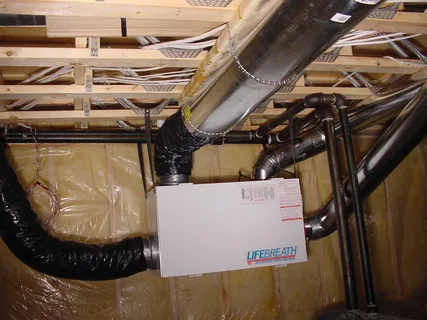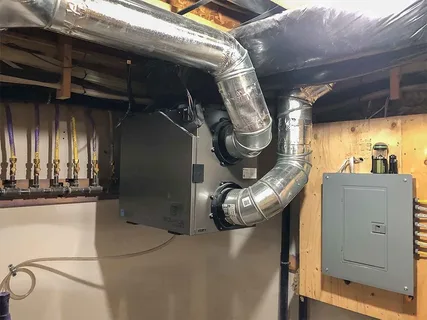Welcome to a breath of fresh air! The importance of breathing easily cannot be overstated in our fast-paced world, where indoor air quality often takes a backseat to other concerns. Enter HRV ventilation systems—an innovative solution to enhance your living and working environments while promoting health and well-being. Imagine stepping into your home or office and feeling immediate comfort as crisp, clean air circulates you. In this blog post, we’re diving deep into the remarkable benefits of Heat Recovery Ventilation (HRV) systems that improve air quality and transform how we experience our spaces.
Introduction to HRV Ventilation System and its importance in homes
Imagine walking into your home and feeling an immediate sense of comfort. The air is fresh, clean, and invigorating. This isn’t just a dream; it’s the reality that an HRV ventilation system can bring to your living space. With increasing indoor air quality awareness, more homeowners recognise the importance of effective ventilation solutions.
Maintaining a healthy environment becomes crucial for our well-being as we spend more time indoors—especially in tightly sealed homes. HRV (Heat Recovery Ventilation) systems play a vital role in transforming stale indoor air into refreshing freshness while minimizing energy loss. They not only enhance comfort but also contribute significantly to energy efficiency.
In this deep dive, we’ll explore what makes HRV systems stand out among various available ventilation options and how they can dramatically improve air quality and cost savings in your home. Get ready to breathe easy as we uncover all there is to know about these innovative solutions!
 Understanding the basics of HRV (Heat Recovery Ventilation) and ERV (Energy Recovery Ventilation)
Understanding the basics of HRV (Heat Recovery Ventilation) and ERV (Energy Recovery Ventilation)
HRV and ERV systems are both vital players in modern home ventilation. They enhance indoor air quality while optimizing energy usage. Heat Recovery Ventilation (HRV) transfers heat between incoming and outgoing air. It captures warmth from stale indoor air to pre-warm the fresh outdoor supply during winter. This process keeps your home cozy without sacrificing fresh airflow.
On the other hand, energy recovery ventilation (ERV) takes things a step further by managing humidity levels. It not only exchanges heat but also moisture between the two airstreams. This feature is particularly beneficial in humid climates where excess moisture can lead to discomfort or mould growth. Both systems work silently behind the scenes, ensuring you breathe cleaner air without wasting precious energy resources. Their design promotes efficiency while maintaining a healthy environment for you and your family.
Benefits of Heat Recovery and Ventilation System
Improved Indoor Air Quality
One of the primary benefits of a heat recovery and ventilation system is its ability to improve indoor air quality. Traditional heating and cooling systems often recirculate stale air, leading to a buildup of pollutants, allergens, and moisture in the home. An HRV system, on the other hand, continuously brings in fresh air from the outside while removing stale air from the inside. This helps to reduce indoor air pollution and create a healthier living environment for you and your family.
Energy Efficiency
Another major advantage of an HRV system is its energy efficiency. These systems use heat exchangers to transfer heat from outgoing stale air to incoming fresh air, reducing the energy needed to heat or cool your home. This saves you money on your energy bills and reduces your carbon footprint by decreasing your home’s overall energy consumption.
Cost Savings
In addition to energy savings, HRV systems can help you save money in other ways. By improving indoor air quality and reducing moisture levels, these systems can prevent issues such as mould growth and damage caused by excess humidity in the long run. This can save you thousands of dollars in potential repairs or renovations.
Comfortable Living Environment
HRV systems also create a more comfortable living environment by maintaining balanced humidity levels throughout the home. When cold outdoor temperatures cause dry indoor conditions in the winter, an HRV system can help maintain proper humidity levels for optimal comfort without sacrificing energy efficiency.
Ease of Maintenance
An important benefit of an HRV system is its ease of maintenance compared to traditional ventilation methods like opening windows or using exhaust fans. Most modern HRVs come with built-in filters that need occasional cleaning or replacement but require much less maintenance than other ventilation alternatives.
Investing in an HRV system offers numerous benefits for homeowners looking for improved indoor air quality, energy efficiency, cost savings, and a comfortable living environment. With regular maintenance and proper usage, an HRV system can provide long-term benefits for your and your family’s health and well-being while reducing your carbon footprint.
How does an HRV System work? Explaining the ventilation process step-by-step
An HRV system operates through a simple yet effective process. It begins with stale indoor air being drawn out of your home. This is typically done in areas where humidity or odors, like kitchens and bathrooms, may accumulate.
This warm air passes over a heat exchanger within the unit as it exits. The magic happens here: Here’sthe outgoing air transfers heat to incoming fresh outdoor air without mixing. Next, fresh outdoor air enters your home warmed by the exchanged heat. This ensures that you maintain a comfortable temperature while refreshing your indoor environment.
The cycle continues as the HRV draws in more stale air and expels old air regularly. This balanced exchange keeps pollutants at bay while optimizing energy use every season, making for a healthier living space all year.
Factors to Consider when Choosing an Air Recovery Ventilation System
Choosing the right air recovery ventilation system for your home involves several key factors. Start by assessing the size of your space. Larger homes may require more robust systems to ensure proper ventilation. Next, consider your local climate. An area with extreme temperatures might benefit from an ERV system instead, as it balances humidity levels along with temperature recovery.
Look into energy efficiency ratings, too. Higher-rated units can lead to significant savings on utility bills over time, making them a smart investment. Don’t overlook noise levels, either. Some models operate quietly, while others may produce noticeable sounds during operation. Lastly, think about maintenance requirements. Systems that are easy to clean and service will save you time and effort in the long run, ensuring consistent performance year after year.
Installation and Maintenance Tips for Optimal Performance of your HRV
Installation and maintenance are crucial factors that can greatly impact the performance of your HRV ventilation system. Proper installation and regular maintenance can ensure optimal functionality and longevity of your HRV, ultimately leading to better indoor air quality and energy efficiency. This section will discuss some important installation and maintenance tips to help you get the most out of your HRV.
Location is Key
The location of your HRV unit plays a significant role in its performance. It is recommended that the unit be installed as close as possible to the main living areas or bedrooms where air circulation is required the most. Additionally, ensure enough space around the unit for easy access during maintenance and filter changes.
Follow the Manufacturer’s Instructions
It is essential to follow the manufacturer’s instructions carefully during installation. Each HRV model may have specific installation requirements, so referring to the manufacturer’s user manual is crucial. This will ensure your HRV operates at its maximum potential without any issues.
Proper Ductwork Installation
The ductwork is critical in ensuring proper air distribution throughout your home. Improperly installed ductwork can lead to uneven airflow, reduced efficiency, and even cause damage to your HVAC system. Hiring a professional HVAC technician with HRV experience is best to ensure proper ductwork installation.
Routine Maintenance
Regular maintenance of your HRV system is vital for optimal performance. The two essential components that require routine maintenance are filters and heat exchangers.
Proper installation and regular maintenance are crucial for the optimal performance of your HRV system. Following these tips will ensure you get the most out of your investment and provide you with clean and fresh indoor air year-round. Remember to consult a professional HVAC technician if you have any concerns or questions regarding the installation or maintenance of your HRV system.
Buy Heat Recovery Ventilator for Energy Efficiency and Cost Savings
To Buy heat recovery ventilator is an excellent way to improve your home’s energy efficiency and save money on utility bills. These systems work by using the heat from stale air being exhausted from your home to warm up the fresh air being brought in from outside. This process helps maintain a comfortable temperature inside your home while reducing the energy needed for heating or cooling.
One of the main benefits of buying an HRV is its potential for significant cost savings. By recycling the warm air inside your home, you can reduce your heating bill by up to 40%. This means you can enjoy a warm and cozy living space without constantly adjusting your thermostat or worrying about high energy costs. Additionally, since these systems use less energy, they also positively impact the environment by reducing carbon emissions.
Another advantage of investing in an HRV is its ability to improve indoor air quality. As we spend more time indoors, it’s essential to ensure that we are breathing in clean and healthy air. An HRV ventilation system helps achieve this by exchanging stale indoor air with fresh outdoor air. It filters out dust, pollen, and other allergens, creating a cleaner and healthier living environment for you and your family.
Conclusion
HRV ventilation systems are a game-changing technology that can greatly improve the air quality and overall health of your home or building. By exchanging stale indoor air with fresh outdoor air, these systems reduce the concentration of pollutants and promote better oxygen circulation throughout the space. Not only do HRV ventilation systems benefit personal health, but they also have positive environmental impacts by reducing energy consumption and carbon emissions. With proper maintenance and usage, these systems can provide long-term benefits for individuals and society.
FAQs:
Q: How often should I clean or replace the filters in my HRV ventilation system?
A: It is recommended that filters be cleaned or replaced every 3-6 months, depending on usage. This will ensure efficient system functioning and prevent dust and pollutants buildup.
Q: Can HRV ventilation systems be installed in any type of building?
A: Yes, HRV ventilation systems can be installed in homes, apartments, offices, schools, hospitals, etc., as long as there is a source of fresh outdoor air available.
Q: Are there any drawbacks to using an HRV ventilation system?
A: The only potential drawback is increased noise levels due to the fans used in the system. However, modern models have been designed with noise reduction features to minimize this issue.
We hope this deep dive into HRV ventilation systems has provided valuable information about their benefits and usage. Always consult a professional for any specific questions or concerns regarding your installation. Breathe easy, knowing you are taking proactive steps to improve indoor air quality and promote better overall health.
| Other Good Articles to Read |
| Blogs Rain |
| Cme Blog Spot |
| Garcias Blogs |
| Yyc Blogs |
| Guiade Blogs |
| Blogs-Hunt |
| Impact-Blog |
| Smarty Blogs |
| Ed Blog |
| Mo Blogs |
| Blogs Em |
| Blogs T |
| Related Business Listings |
| Contact Directory |
| Local Business Profiles |



